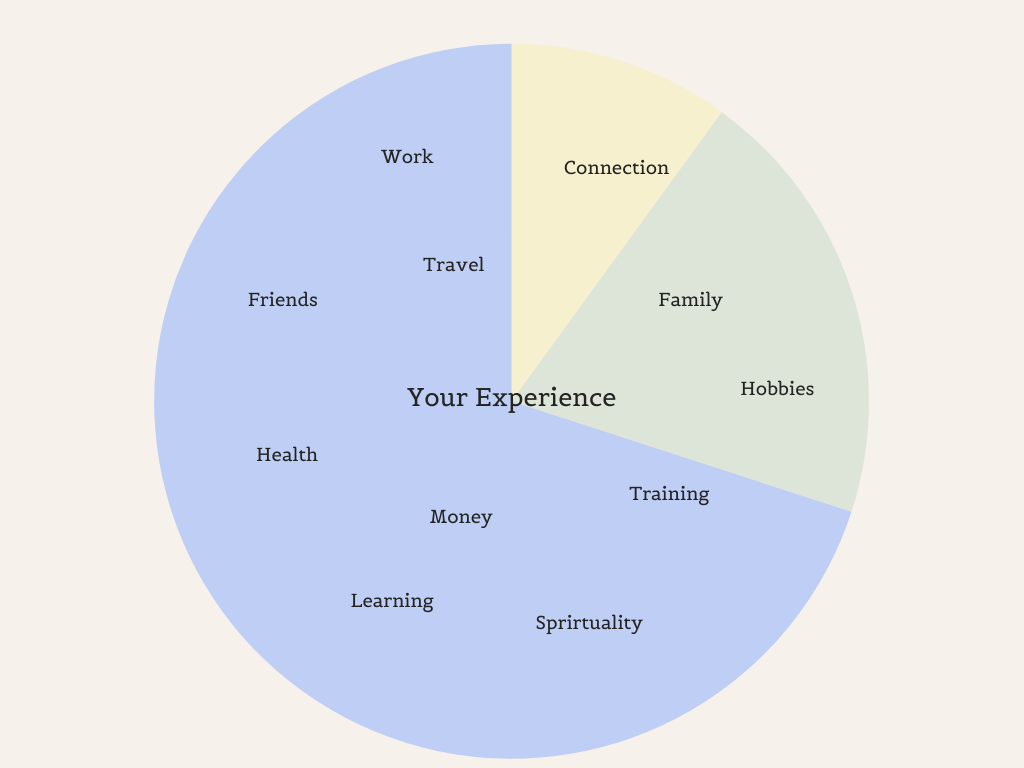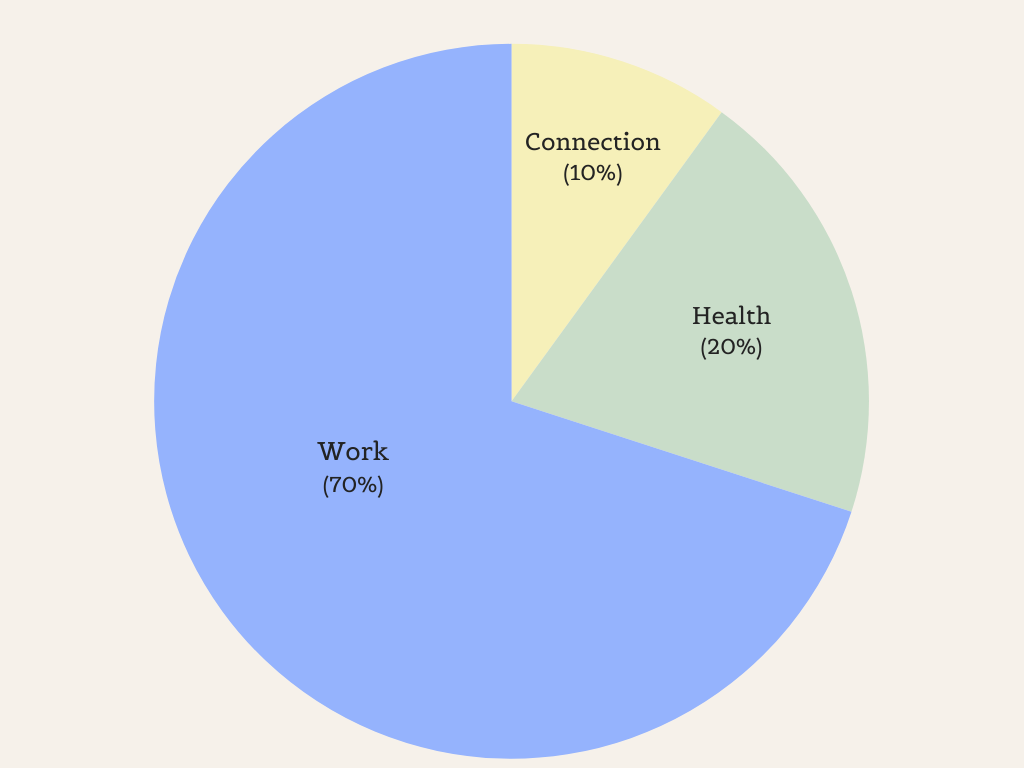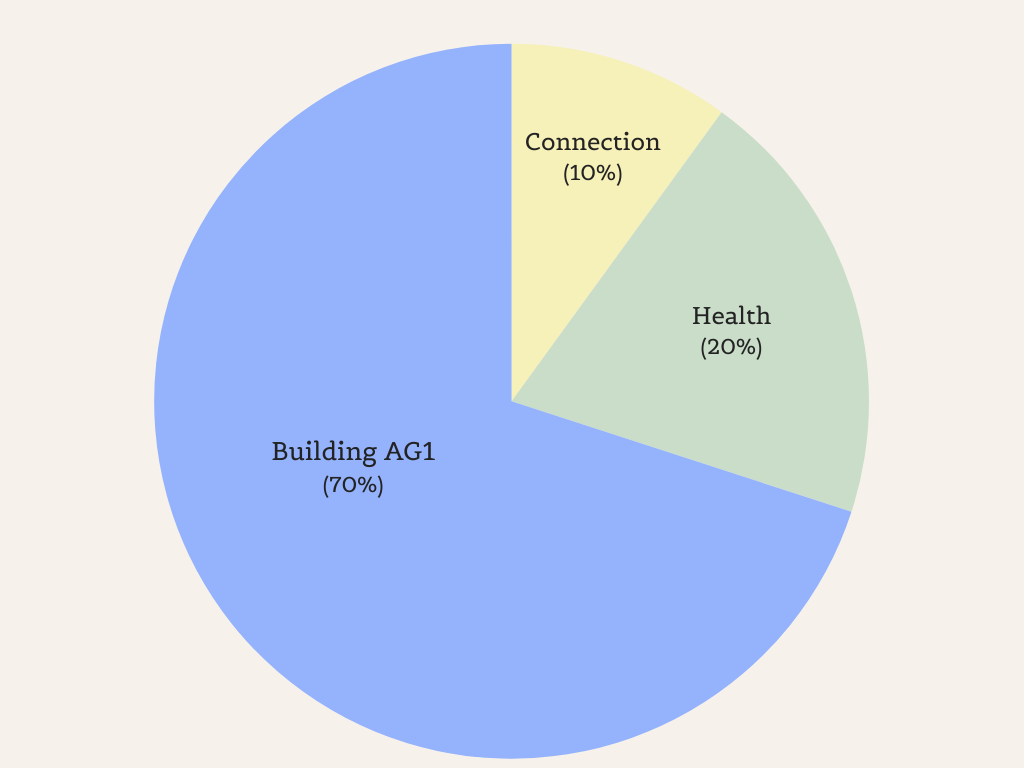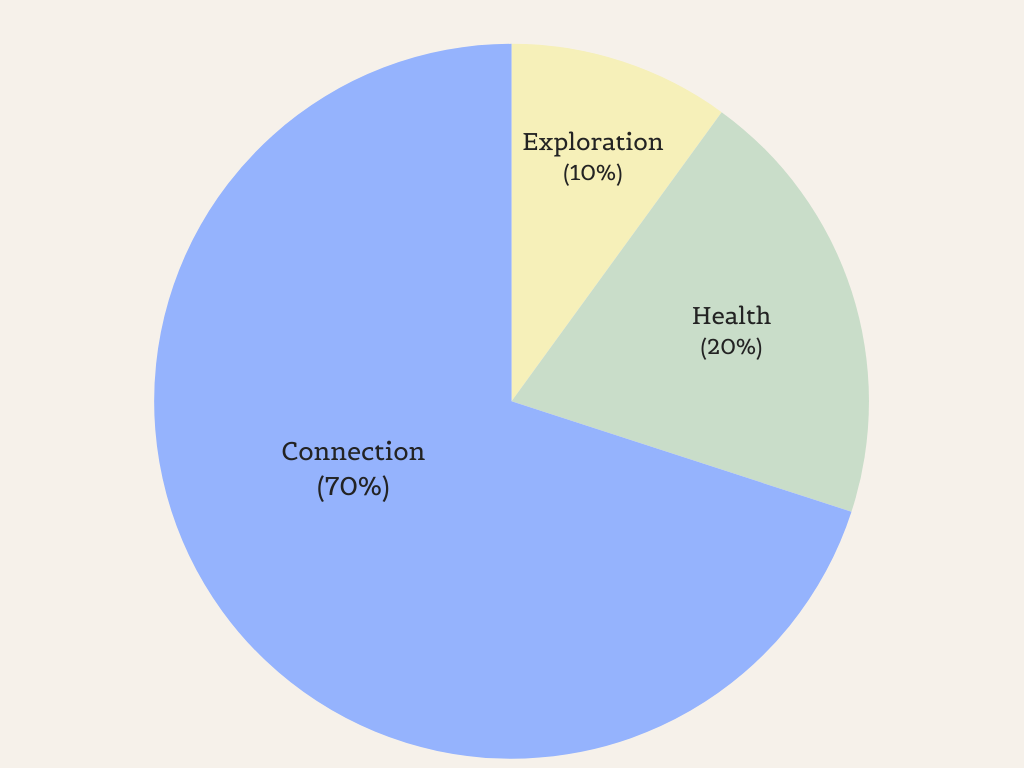we proclaim that we are either in balance or imbalanced — yet these headlines only brand us for a brief moment. they remain static in their description, usually neglecting the one true constant: change. yet, the true experience of one’s journey travels in the currents — beneath the surface where its flow is in a constant dance of rebalancing. when we fail to rebalance we travel towards the end of our tether, meeting the edge of our resilience, branding ourselves again with: burnout, overtraining, boredom, overcorrection, regression. we free fall into these headlines, announcing our diminishing returns inside it's different contexts, all pointing towards a misalignment and a need to rebalance. life isn’t a balancing act, it’s a rebalancing act. with intervals of living, recovering, reflecting, readjusting, redirecting and living again. seldom are there other activities with higher ROI than checking in with yourself — it’s time well invested. t is here, in these quiet reflections, where we reconnect with our resilience, finding the capacity to change course, ascend, and find the steps to move forward.
How do I manage my energy to get the highest returns in certain focus areas of my life without feeling the guilt or shame that may come with investing too much time in one area?
How do I move walk the path along the stones that keeps me from entering lava flowing with burnout, boredom, overtraining…?
For a long time, every so often, these questions stole my attention as I tried to manage work, health, relationships, hobbies, training, traveling, learning and all other things I decided to absorb in my sphere of focus.
My solution found itself in a concept mostly (and likely originally) tied to the eighth wonder of the world and an approach investing your cash — Weighted Portfolio Management.
Its core principle and has transcended a number contexts in my life one – in particular being how I manage and weight attention and energy via my Energy Portfolio Management.
Over the past five years it’s been a key practice of mine used as a weighted focus and prioritization mechanism to generate the greatest returns on my chosen experience.
After all, where focus goes, energy flows.
burnout misalignment
Its origin story came when the standard definition of burnout fell out of sight for me back in 2019.
It said that if you worked too hard, you would burn out.
I enjoyed working hard and sometimes felt the negative connotations attached to those that did. And spending a lot of time with many entrepreneurs and operators who also found joy in working hard only compounded the distance to the definition such that it began to lose its power and relatability.
It spawned an interrogation of the word – diving beneath and exploring the pathway towards, and the experience of it, rather than the labeling and branding of it. I began to notice that burnout wasn’t exclusive to the work environment and it wasn’t necessarily related to how hard I was working at all. It was being carelessly used as the headline that breached the surface of a series of experiences culminating at the “dead end” of alignment.
As I investigated this materializing of my experience, I had this visual of an indestructible piece of rope beginning to fray as it begins to approach the limits of a tolerable strain. I’d find myself at the end of my tether splaying into feelings of apathy inside whatever the core focus area of my life was at the time, experiencing reduced agility into other important areas, decision fatigue and anxiety inside the complacency finding life inside indecision, impatience with others and myself, a constant opting for convenience over exploration, and unconsciously seeking safety inside routine over the necessary exposure to variety.
In other words, my energy would become more transactional.
Often, my reaction to the feelings was to overcorrect on the activity or focus, which eventually led to the same feeling.
I then began to notice arenas beyond myself where burnout and overcorrection were present as a collective – society, teams, business strategies or other aggregations of people or ideas.
At the grandest scale I observed this inside the arena of politics as the mass swings from one extreme to the other to overcorrect the weighted-average sentiment at the time.
The media would then exploit burnout as its black and whiteness held little space for the shades of gray that housed the nuance of the truth.
Consequently, the interrogation left me thinking we were communicating in headlines and that burnout was just a wrapper to a misunderstanding of how myself and others felt.
It was also true that these feelings transcended context. While this was present at times where building AG1 was the core focus of my life, the familiar undercurrent of burnout was felt when I switched the focus to other categories – family, training, friends, eating habits or relaxation to name a few – and spent a heavy percentage of my energy in one of those categories for an extended period of time.
But how could you experience burnout inside family contexts or eating habits or relaxation?
As I was experiencing the same feelings across categories, the truth felt closer towards the depths of misalignment – this feeling that I was neglecting the entirety of who I am and what I enjoyed. Being so heavily weighted and invested in one area of my life under a long sustained period meant that I held little energy and space for other parts of me that summed up to the whole.
I noticed we have different words for burnout in different contexts:
When it’s work it’s called burnout.
When it’s relaxing it’s called boredom.
When it’s training it’s called overtraining.
When it’s family time it’s called re-childing.
When it’s politics or the market it’s called overcorrection.
Whatever the label is, inside the activity or focus area exists an eventual diminishing returns.
In ourselves, this manifests in diminishing returns on our energy as we neglect parts of ourselves. Along with those diminishing returns on the core area of focus at the time, also exists an inability to transfer energy into other areas of joy due to decision fatigue, apathy, a sense of ineffectiveness and a constant regression towards safety in the routine.
Burnout no longer attached itself to “working hard” – rather, it was a summary of (1) spending too much time (2) at too high of an intensity (3) in one area of my life, and (4) neglecting the other meaningful parts for a sustained period of time.
When you exist inside this misalignment and the neglect of the pieces of you, you feel trapped, choice diminishes, and when choice diminishes we can feel slave to our existence. Stuck.
Energy Portfolio Management
By this point I felt I understood the nuance of the problem and was well equipped to experiment with solutions.
For whatever reason I mapped myself back to one of the only concepts I retained from university – investment portfolio management.
The concept of investment portfolio management involved selecting a risk-adjusted return profile over a certain time horizon that would then allocate your dollars across various asset classes. Think of it as allocating and weighting 60% of your cash across treasury bonds or the S&P 500, 20-30% across individual stock picks and 10-20% for crypto or high risk assets to achieve a desired return.
Rather than leave this weighting in perpetuity, you would want to continue to rebalance the investments as they undergo performance fluctuations and you continue to aim for the target return. Additionally, you might decide that your risk tolerance has increased or decreased and therefore you are willing to change the weightings in each asset class to deliver greater or lesser returns over that given time period.
This concept, like compound interest, felt like a core principle that could be applied to life and in particular my attention and my energy.
This led to my practice of energy portfolio management.
Instead of dollars invested, it was my energy (attention and time) that was being invested, and instead of asset classes it was important areas of my life that would receive that allocation of energy.
For example, I might have 70% of my energy allocated towards work, 20% allocated towards health and 10% allocated towards friends, family and travel. I would then apply these weightings to my attention, time and energy and directionally live with this allocation for a period of time. It could have looked like the following:
Where I spend most of my energy is where the blue ocean exists. The flow, the force and the sheer size of it. means whichever way the current is flowing tends to match my experience.
The green energy is where I’m getting a healthy dose of that area with enough active participation for things to grow incrementally.
The sand colored is where the desert exists – less, but non-existent – just less nurtured.
This is my world. This is my experience.
The result of this practice is a contract with yourself and others if well communicated. It materializes the rules of the game you have chosen to play out over the next determined period.
It creates a sense of ownership – ownership in your decisions; power – power over your energy; and removes the shame or guilt that might come from the inner voice or outer voices that say “you’re spending too much time doing……”
Ultimately, it creates a sense of inner freedom.
However, as mentioned, energy and attention weighted heavily and consistently in one area of your life for too long can lead to diminishing returns. It takes awareness to notice yourself at the end of your tether, fraying and splaying into negative habits and energy.
I noticed that the time horizon in which I could allocate the majority of my energy portfolio in one direction was context dependent (hint: as are all things).
At work, this time horizon typically lasted 90-100 days (spending time with my family was about three minutes – I’m joking, my mother reads this, hi mum, love you…it was closer to four minutes).
It seemed I could focus and weigh an intense amount of time, attention and energy into work, however by day 80 I would start experiencing the diminishing self.
I decided to create a mechanism of interruption to induce reflection, re-choosing and renegotiating a new contract with myself around day 75-80. This reflection often consisted with a dialogue:
How is your current energy?
Are you feeling impatient, defensive, apathetic, irritable?
Who inside of you do you feel like you are neglecting?
Do you need to take your foot off the gas?
If not, who do you need to communicate with?
Are you going to renew the current allocation for 30, 60 or 90 days?
Or, does it need some rebalancing (i.e. reduce work from 80% to 65% and increase friendship from 10-25%)?
It may have been that after such reflection I continued on the current path for another segment or opted for a new allocation providing different returns in each of the areas important to me.
If I was going to resubscribe to the same portfolio weightings and extend the execution window, then I needed to create some time for recovery in between to allow me energy stores to fill up again. Like any muscle after an intense phase of work, recovery is necessary to deliver the same or better output.
Regardless of how frequently you review the contracts with yourself, what became the most powerful aspect about these pauses and reflections is the freedom you felt inside your choices – the power to direct and redirect your energy without shame, fear or guilt. Your energy is then consciously and intentionally periodized into a series of sprints – you hold the power to opt into your recent experience or choose differently.
For the seven years that followed May 2017 building Athletic Greens (AG1), the weighted average allocation of my portfolio looked a lot like the below:
It was an intentionally chosen attention investment strategy.
I allocated a large amount of my energy working with the team to build one of the most recognizable brands in the health space. It left me with an immense amount of gratitude for what I learned, for those that it helped on their health journey and for those I met along the way. It also left me with an enormous amount of pride for what was a 10-ish person and $10-ish million ARR business at the time (2017) and evolving into a brand serving millions of people around the world.
Now, and for the last eight months, my energy portfolio has seen a massive redistribution of it’s energy, closely representing the below:
As a good mate put it to me so eloquently – I’m a full-time friend. I help them out at home, with their kids, their businesses, their lives. I have been living in this new portfolio of mine for eight months now and I’m grateful for the returns and almost ready for the next reallocation.
I believe there is no perfect distribution or perfect balance across your areas of choice. Only constant rebalancing. Outsized returns only come with heavier weighted directed attention in very few places at one time. Choose, play, pause, reflect, rebalance, then choose again.
I encourage you to look beneath the “burnout” and take the time to reflect on any potential misalignment. I’ve never met anyone who regretted the time they took to look within.
Now pause, reflect, rebalance, choose and range freely.





Couldn’t agree more, this is smart. I have much to learn from you sensei.